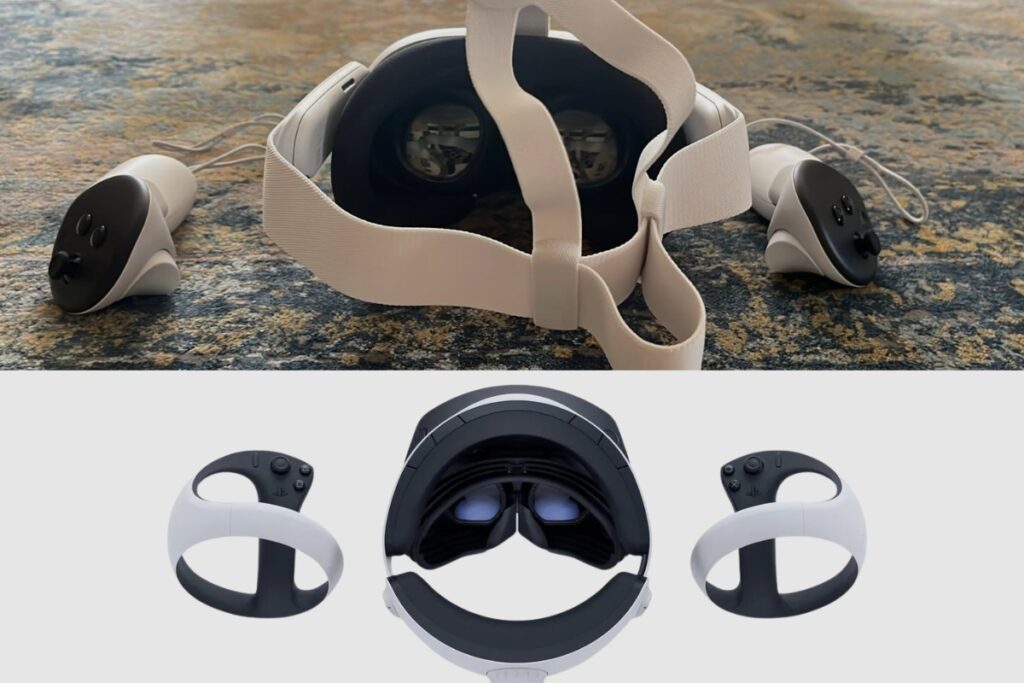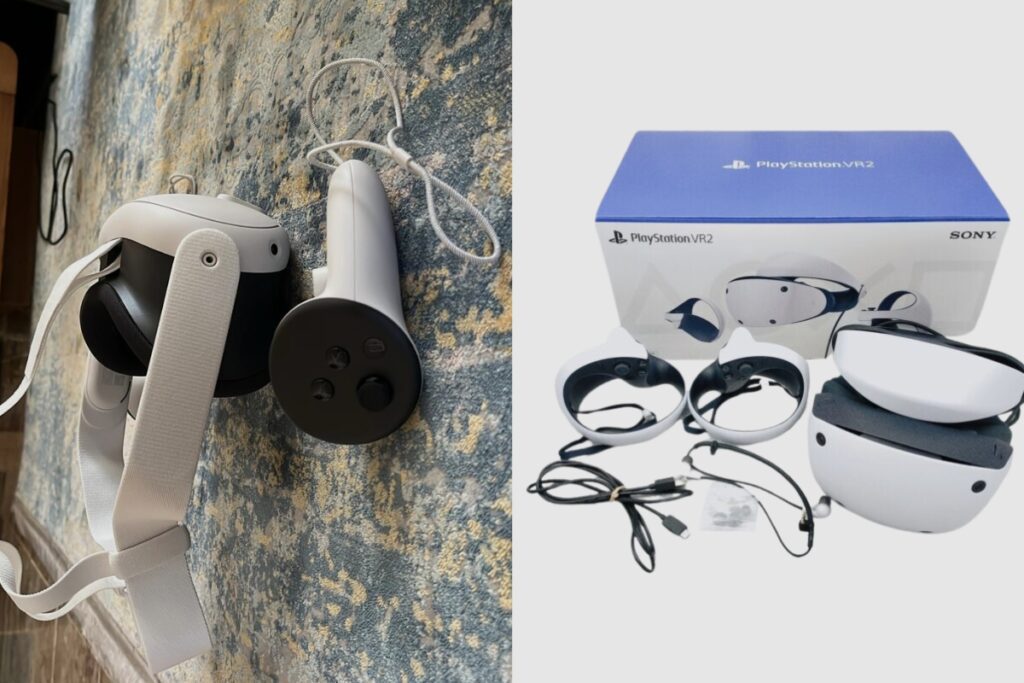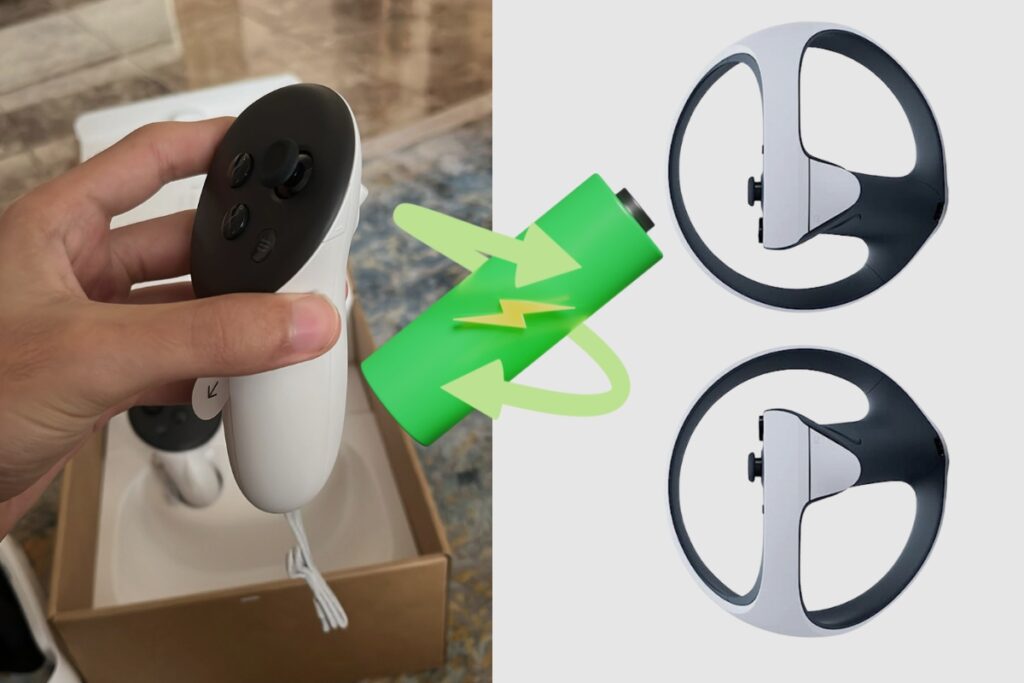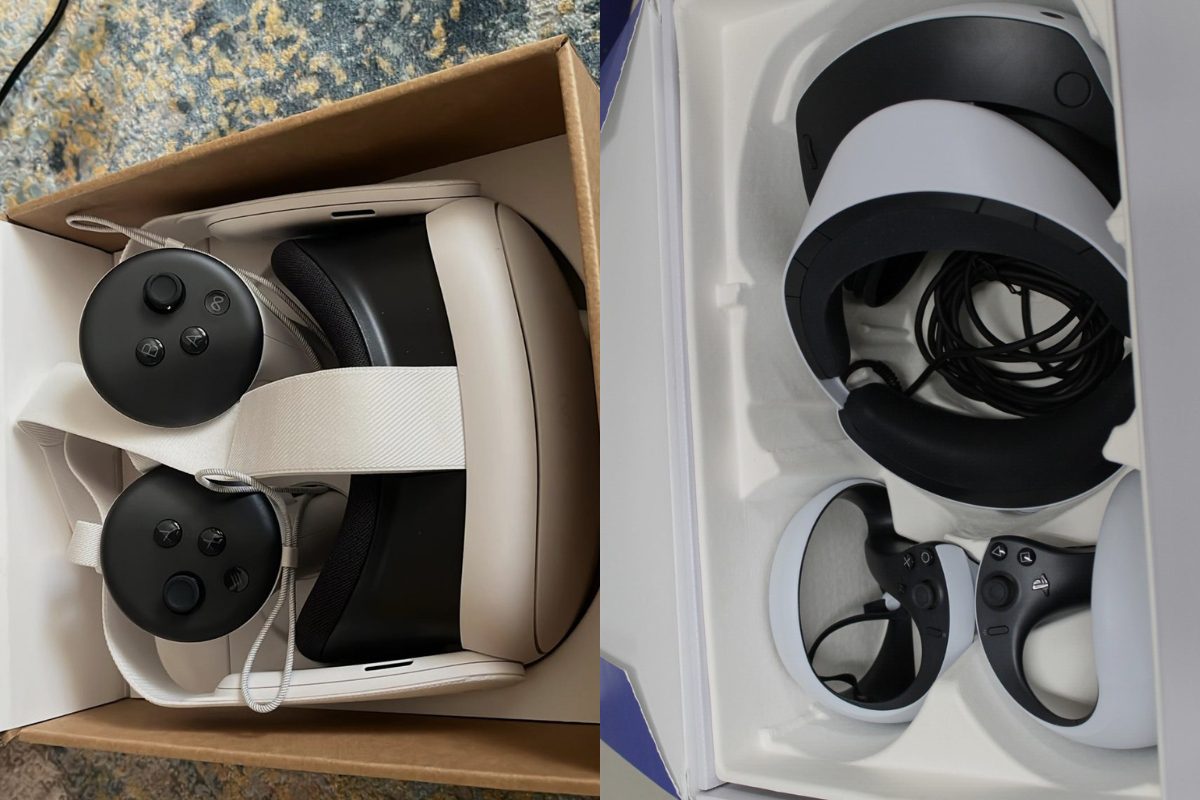When it comes to virtual reality gaming in the consumer market, there are two undeniable dominant forces. Both the Meta Quest 3 and Sony PSVR 2 have developed such a stronghold in the market that each console has become almost synonymous with VR gaming.
However, when it comes to picking which console works best, it can get tricky. While they have outstanding features, they are still two very different consoles. The Meta Quest 3 is a standalone headset, while the PSVR 2 is an impressive add-on to the PlayStation 5 console. So, with that in mind, I thought it would be an idea to compare the Meta Quest 3 and PSVR 2 to see which one is better.
- Will the Meta Quest 3 Be Better Than the PSVR 2?
- Specs
- Design and Build Quality Comparisons
- Display Quality
- Performance comparisons
- Audio Quality
- Heat Management
- Gaming Libraries and Platforms
- Controller Comparisons
- Controller Battery Life
- Mixed Reality Considerations
- Connectivity Considerations
- Price Comparisons
- Pros and Cons of the Meta Quest 3
- Pros and Cons of the PSVR 2
- Final Thoughts
Will the Meta Quest 3 Be Better Than the PSVR 2?
There are a lot of differences between the Quest 3 and PSVR 2, from its overall design to its software and build quality. The differences are a lot, so why don’t we start with the specs and work our way down to see which one is better for ourselves?

Specs
When comparing two devices, the best place to start is with a quick recap of each of their specs to briefly examine how they stack up against each other.
| Category | Meta Quest 3 | PSVR 2 |
Chipset | Snapdragon XR2 Gen 2 | PS5 System |
| Resolution: | 2,064 x 2,208 pixels per eye | 4K OLED, 2,000 x 2,040 per eye |
| Storage | 128GB,256GB | On board PS5 |
| RAM | 8GB | Nil |
| Battery life | 2.2 hours (rated) | Onboard |
| Size | 7.2 x 6.2 x 3.8 inches | 7.9 x 4 x 5.5 inches |
| Weight | 18.2 ounces | 19.8 ounces |
Design and Build Quality Comparisons
The Quest 3 and PSVR 2 approach their industrial design ethos in quite different ways. With its plastic construction materials and cloth straps, the Quest 3 favours a simple, minimalist design. The PSVR 2, on the other hand, features a more upscale design, including opulent curves and a glassy front visor lens. The basic charcoal and black colouring of the Quest is contrasted with the faded white finish.
The Meta Quest 3 is notably slimmer, particularly when compared to the Meta Quest 2. After using both, I can vouch for Meta’s claim that the visor, or visual interface, is 40% thinner than it was. As a result, wearing the Quest 3 is more ergonomically balanced. It’s not like I totally forgot I had a headset on (duhh), but there was definitely a change from the top-heavy Quest 2.
For users like me who require glasses, Meta was able to do away with the spacer because of the more streamlined design. Instead, two black buttons inside the headset allow you to simply modify the facial interface to offer you extra room when needed. A new IPD wheel is also included to change the separation between the lenses. For me, the default settings of the Quest 3 made it easy to use it with my spectacles, but I could simply alter them.
As for Sony’s PSVR 2, it should come as no surprise that the PSVR 2 is an improvement over the PSVR. With a few tweaks, such as combining the tightening wheel and headband release button onto the back of the band, it keeps the single plastic headband from its predecessor.
Rubberized padding for the wearer’s forehead and back of the head is located inside the headband. The light shield that encircles the wearer’s eyes is made of a significantly more flexible and softer rubber. Here’s where the first significant distinction between the PSVR 2 and PSVR becomes clear: the latter headgear lets in enough light to be rather disturbing, whereas the former lets in none at all. The PSVR 2 is now instantly more immersive than the PSVR, thanks to this.
Additionally, it’s a comfy headset that isn’t too heavy (weighing about 560g/19.8 oz without the wires), but you won’t forget you’re wearing it. Furthermore, even though the rubber eye shield isn’t exactly made of the softest materials, I was able to use it for almost an hour without experiencing any discomfort. True, I started to feel the top of the shield pressing against my forehead, and my face was getting heated, but it was quickly alleviated with a small adjustment.
Personal Thoughts
Both headsets have fairly balanced ergonomics, although the PSVR 2’s bigger head strap might provide a stronger grip during vigorous VR sessions. The in-ear integrated headphones on the PSVR 2 are superior to the hidden audio solution seen in the Quest 3. In terms of weight, the Quest 3 is the lighter option because it weighs about 500g as opposed to 600g for the PSVR 2. The PSVR 2 effectively counterbalances its mass, though, so the weight difference is almost insignificant.
Concerning ports and connectors, the PSVR 2 exclusively uses Sony’s proprietary connector for console pairing, but the Quest 3 maintains simplicity with a USB-C connection. As a result, Quest 3 now has additional options when it comes to connecting external devices and accessories. As opposed to the Quest 3, which was engineered at a higher cost, the PSVR 2 aims for superior build quality and style overall.

Display Quality
The Meta Quest 3’s dual 2064 x 2208 LCD eye displays have a 30% higher pixel density than the Quest 2. This 30% enhancement will result in a far better visual experience for Quest 3 players. Menus, in-game HUDs, and virtual browsers are some of the best instances of textural elements. Furthermore, it will support a refresh rate of 120Hz at launch, which means that fast-paced games like “Beat Sabre” will have much higher frame rates. Every game I tried had an incredibly clear picture, thanks in part to the enhanced resolution and fish-eye optics of the Quest 3.
On the other hand, the PSVR 2 comes with a resolution of 2000 x 2040, which displays at 4K by giving each eye 2000 x 2040 pixels. With everything looking clearer and sharper on the PSVR 2, this is a significant improvement. I believe this significantly lowers the possibility of headaches and eye fatigue.
Like its predecessor, the PSVR 2 has a display with a refresh rate of between 90 and 120 Hz. Because of this, the headset can accommodate frame rates high enough to reduce the motion sickness that some VR headsets cause. Although I don’t get nausea from virtual reality very often, the PSVR 2’s display feels responsive and silky, with very little distortion or flicker to take my attention away from the virtual environment I was in.
Although a field of view (FOV) greater than 100 degrees is quite acceptable, a 110-degree FOV expands upon the PSVR’s 100 degrees. My vision was occupied by the PSVR 2’s display, and I hardly ever felt like I was swiping about a virtual environment instead of staring at a screen via some goggles.
Personal Thoughts
While both headsets have high-quality displays, they work with distinct technologies by design. With two LCDs per eye that have a resolution of 2064 x 2040, the Quest 3 can produce images that are nearly 4K in size. In contrast, each eye of the PSVR 2 is equipped with OLED displays that have a resolution of 2000 x 2040. Using OLED gives you a noticeable advantage in terms of contrast and dark levels, which result in punchier visuals, even though the Quest 3 wins in terms of overall resolution.

Performance comparisons
The display refresh rate has a significant influence on the perceived responsiveness and smoothness of VR visuals. For smooth, clear motion, the PSVR 2 can operate in 90Hz or 120Hz modes in this instance. In contrast, the Quest 3 can only experimentally attain 120Hz, although it offers 90Hz natively. In terms of silky smooth refresh rates, the PSVR 2 wins.
However, you must realise that computing power also plays a major role in defining the smoothness of graphics and effects, and refresh rates are only half the story. Here’s where Quest 3 makes a strong comeback. With Qualcomm’s state-of-the-art Snapdragon XR2+ architecture, the Quest 3 renders images far quicker than the XR2, which is now outdated in PSVR 2.
Personal Thoughts
The Quest 3 offers significantly more sophisticated physics, particles, lighting, texturing, and post-processing than the PSVR 2 hardware can match, according to real-world data. In summary, the Quest 3’s brute force processing powers unleash noticeably more realistic and immersive graphical experiences, even though the PSVR 2 excels in refresh rates.
Audio Quality
VR immersion requires sound, and the PSVR 2 raises the bar with its built-in headphones and Tempest 3D audio augmentation. With their trademark Tempest processing, the off-ear headphones produce remarkably realistic positional audio that reacts dynamically to your movements and head rotation. They also offer deep bass and clean, directional sound. You can immediately feel the headgear giving you a sense of presence.
In contrast, the Quest 3 uses high-quality spatial audio projection using hidden strap speakers. Compared to the PSVR 2 audio package, the impression of realism is notably more bland and unconvincing. Quest 3’s audio is passable, but it doesn’t have the same level of realistic soundscape as Tempest. There is no denying that Sony leads the way in terms of audio integration. Here, the PSVR 2 is the undisputed winner.

Heat Management
The Quest 3’s small form factor comes with a price: concentrated heat accumulation during prolonged gaming sessions. After using it continuously for more than 30 minutes, the improved processor and power-hungry displays cause considerable warmth to radiate from the front and sides.
However, because of its soft detachable face gasket and more open and ventilated design, the PSVR 2 offers superior airflow and heat distribution. The specialised platform of the PlayStation 5 naturally facilitates cooler operation of integrated hardware. According to tests, the PSVR 2’s effective active cooling system and heat dispersing engineering assure that users will experience the least amount of heat damage.
Personal Thoughts
The PSVR 2 is a better option for people who value comfort because of its constant cool operation, which is likely to be far more appealing to those who are prone to sweating or discomfort from warmth on their face than the Quest 3’s tendency to run hot with prolonged playtimes.
Gaming Libraries and Platforms
You can play a great deal of games with the Quest 3, including all 500+ Quest 2 games and apps in addition to brand-new Quest 3 titles. Additionally, it improves a few of the current Quest 2 games for those who can benefit from the better performance of the Quest 3.
I have played a fair number of titles in the Quest 3, even though I haven’t had a chance to test them all. Old-school Quest 2 titles like NFL Pro Era and Superhot VR remain fun to play, and Quest 3’s enhanced graphics help Pistol Whip perform better. Like Assassin’s Creed Nexus, Native Quest 3 is striking to look at.
The one thing that I found unimpressive was Xtadium, Meta’s VR app for watching sports events. Rather than seeing the feed from an HD or 4K 180-degree or 360-degree camera, it felt like a subpar non-HD video feed was being superimposed over a backdrop. Perhaps this is because I could only view highlights. I’m hoping that when this feature broadcasts live NBA games, it will appear better because, right now, I wouldn’t pick it over my TV, much less a live game.
As for the PSVR 2, virtual reality games that have been converted to the new headset are highly functional. However, I’m going to concentrate on Horizon Call of the Mountain, which was created entirely for PSVR 2 by Guerrilla Games and developer Firesprite. Call of the Mountain is a great example of the PSVR 2’s technology and quality, even though it’s a full game rather than simply a brief VR experience.
Without giving anything away, Call of the Mountain puts you in the shoes of Ryas, a disgraced soldier on a mission of atonement by aiding his once-foes and trying to find a missing person on a mountain.
According to what I’ve played so far, the plot is typical Horizon material, which is good news if you like Horizon Zero Dawn and Horizon Forbidden West.
In terms of sheer visuals, Call of the Mountain falls short of Forbidden West since it must operate at 4K and a high frame rate. Nevertheless, with its vibrant valleys, snow-capped mountains, engaging NPCs, and generous use of volumetric effects, it still looks fantastic. Furthermore, PSVR 2 has let me feel even more fully immersed in Horizon’s post-apocalyptic Earth.
With around 30 VR games released between February and March, the PSVR 2 doesn’t lack a selection, considering the quantity of VR games already available in general and those on the original PSVR. However, given its price and exclusivity to the PS5, I’m hoping to see more innovative and committed PSVR 2 titles that make the most of its capabilities.
A VR upgrade for Resident Evil Village and Gran Turismo 7 is on the way, so the PSVR 2 will soon have access to some longer VR experiences. However, I sincerely hope Sony uses the strength of its first-party studios, like Santa Monica and Naughty Dog, to produce all-new PSVR 2 games. Given that Sony claims to have over 100 PS VR2 games in production, I have a cautious optimism that the PSVR 2 will see a greater number of better games than its predecessor.
As an alternative, Sony might enable PC connectivity for the PSVR 2, perhaps by developing a VR interface for Windows. Given that Sony has been releasing games on the PC, this isn’t totally out of the ordinary, but I wouldn’t count on PSVR 2 PC compatibility happening anytime soon.
Personal Thoughts
While the Meta Quest 3 may have the larger game library of the two, the PSVR 2 is quickly gaining ground on the Quest 3, and I do not doubt that it will catch up to the Quest 3 sooner rather than later. However, I’ll have to give this round to the Quest 3.

Controller Comparisons
The most noticeable modification that Meta has made to these controllers is the elimination of the heavy infrared rings that were included on earlier Quest controllers. Meta made the correct decision in terms of ergonomics with this update.
With the “rings” removed, the revised controllers feel lighter in the hands and appear less top-heavy and unbalanced. They feel nearly flawless at this point. But how has the tracking accuracy changed once the “rings” were removed? In a nutshell, they are no longer necessary.
Meta claims that the new “Touch Plus” controllers for the Quest 3 have more accurate AI hand-tracking than the IR rings that were previously in use. A mixture of infrared LEDs from the visor’s cameras are used by the controls.
Conversely, the Sense controllers of the PSVR 2 can be characterised as a hybrid of the DualSense and Quest 2 controllers. Their form is comparable, albeit larger, and they feature a grip akin to a pistol that extends into a ring for motion tracking. Here’s where the PSVR 2 differs from the Quest 2, where the ring protrudes at the ends of the controller, whereas here it sits further back, virtually looping around the wrist.
The two-tone design of the Sense controllers gives them a cool sci-fi appearance. They seemed rather nice to me, though occasionally, I had to take a moment to recognise which controller was for which hand.
Each controller has a clickable thumbstick, a PlayStation button, a small button for reorienting the headset’s front view, and two buttons on top: square and triangle for the left controller and circle and X for the right. A button on the controllers’ grips, located almost beneath the middle finger, controls L1 and R1 functions. Additionally, L2 and R2 are triggers that use the DualSense controller’s adaptive technology.
The thumbsticks and buttons have a tactile click and feel significantly better than those on the Quest while being slightly smaller than those on the normal controller. The build quality is excellent.
The only small gripe I have is that because of where the ring is located on the controllers, I found it a little difficult to put the wrist straps on. However, if they become bothersome, they can be taken out.
Personal Thoughts
The thing is, I’m a big PlayStation 5 fan, and I absolutely enjoy using the PSVR controllers, so it is hard to give this round to the Quest 3 because it has an incredible set of controllers. However, I’ll have to leave my personal feelings aside and crown the Quest 3 as the winner here.

Controller Battery Life
The headsets are expected to last for approximately two hours when fully charged; however, the controllers are not the same. With interchangeable AA batteries, the new Sense controllers for PSVR 2 offer more than 20 hours of uptime between changes. In contrast, the Touch Pro controllers in Quest 3 require direct USB-C recharging and have a four- to six-hour battery life.
We must also take into account the fact that the Quest 3’s batteries are likewise non-replaceable. The PSVR 2 has a significant advantage over the Sense controllers because of their AA simplicity and versatility for extended marathon sessions. Quest 3 just does not allow for hours of uninterrupted VR gaming without regularly docking controllers for charging.
Mixed Reality Considerations
The distinction between virtual and real worlds can be blurred with augmented reality overlays of your actual surroundings, made possible by the full-colour passthrough cameras of the Quest 3. Regretfully, PSVR 2 is currently devoid of mixed reality functionality. However, perhaps that could be altered in a future update. (Giving you a look, Sony.)
Connectivity Considerations
Regarding connectivity, the Quest 3 can connect to gaming PCs to access material designed for the Oculus Rift. However, the PSVR 2 is still isolated from ecosystems outside of the PlayStation.
Price Comparisons
Released on February 22, the PSVR 2 is available for purchase through the PlayStation Direct Shop, directly from Sony.
At $549.99 / £529.99 / €599.99 / AU$879 at launch, the PSVR 2 is by no means an inexpensive impulsive purchase. Purchasing a product that requires a PS5 to function will cost more than the price of a basic PS5. I completely understand if that thought is offputting to you.
However, the Meta Quest 3 may be bought from Meta’s online store anywhere in the world, as well as from a few local stores, such as Best Buy in the US. Quest 3 comes in two models. The one I tested was the $499 / £479 / €549 / AU$799 variants with 128GB of storage. You’ll have to pay more for the 512GB variant, which retails for $649 / £619 / €699 / AU$949.

Pros and Cons of the Meta Quest 3
Pros
- Colour pass-through cameras allow you to see your surroundings clearly.
- It generates high-quality photos.
- Processor with high performance
- Pleasing style
Cons
- Short battery life
- Lacks eye-tracking tech
Pros and Cons of the PSVR 2
Pros
- Simple to set up
- Excellent haptic feedback controls
- Beautiful exhibition
- Overall, a very good virtual reality experience
- High-end VR is accessible without a gaming PC
Cons
- Short controller battery life
- It costs more than a PS5
- The controller straps are awkward
Final Thoughts
When everything is said and done, both the Quest 3 and the PSVR 2 offer significant advancements in standalone VR experiences. Every headset has several significant advantages over the others and its predecessor. Thanks to its cross-platform compatibility, social media integration, and controller-free input, the Quest 3 is incredibly versatile, seamlessly fusing gaming with other activities.
With the most natural input experiences possible thanks to finger-tracking sense controllers, superior industrial design, enhanced comfort, and best-in-class audio immersion, Sony simultaneously challenges the PSVR 2. Both headsets involve trade-offs based on priorities; there is no clear winner who can dominate every category.
It all comes down to personal preference. The PSVR 2 naturally caters to loyal PlayStation gamers who are highly invested in Sony’s environment, whereas the Quest 3 appeals to VR fans who desire versatility between platforms.

